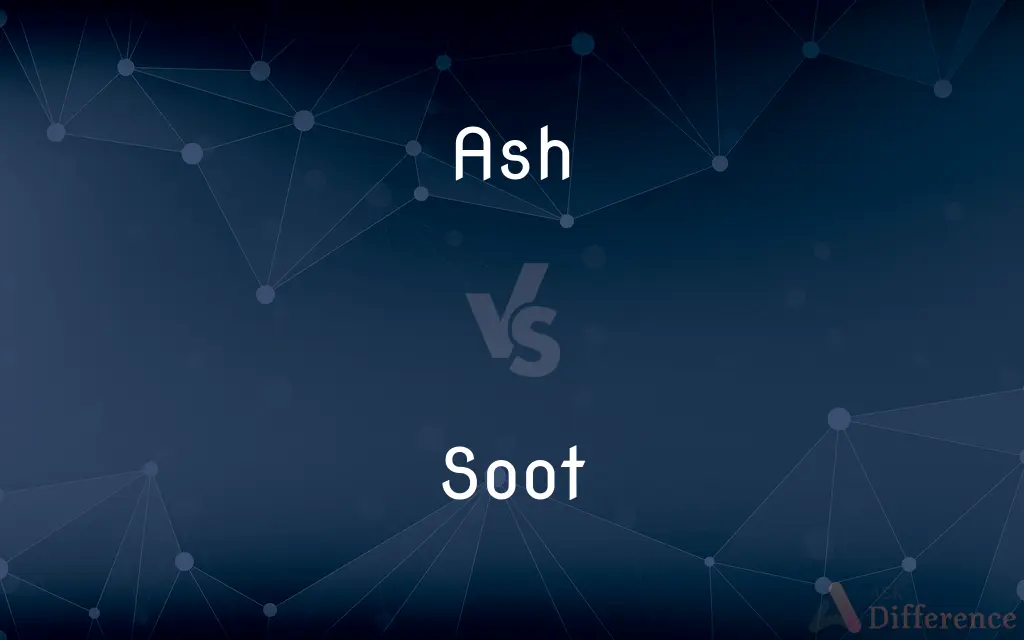Ash vs. Soot — What's the Difference?
By Tayyaba Rehman — Updated on November 1, 2023
Ash is the non-combustible residue left after a substance burns, while soot is the fine black particles produced by incomplete combustion, often clinging to surfaces as a powdery deposit.

Difference Between Ash and Soot
Table of Contents
ADVERTISEMENT
Key Differences
Ash is the powdery residue left after the burning of any material, typically solid and composed of mineral content that did not combust. Soot, however, is a black powder that is a byproduct of incomplete combustion, consisting largely of amorphous carbon and is often associated with smoke.
Ash is inert, does not burn further, and is the end product after all combustible materials are consumed. It can be heavy and accumulate at the bottom of a combustion chamber. Soot is made up of tiny carbon particles that can remain suspended in the air, contributing to pollution, and it often settles on surfaces as a sticky or dusty film.
Ash can vary in color from white to gray and has a coarse texture, while soot is consistently black and can be either a fine powder or a sticky substance. Ash is commonly handled and removed from combustion areas, such as fireplaces or stoves, while soot may require cleaning from surfaces like walls, ceilings, and other areas where it has deposited.
The presence of ash is a natural part of the burning process for many materials, including wood and coal. Soot, on the other hand, is an indicator of inefficient combustion and can be minimized with proper fuel-burning techniques, such as ensuring an adequate supply of oxygen to the flame.
In environmental and health considerations, ash can be a nuisance and may contain harmful substances depending on what was burned, but it is generally less harmful than soot. Soot is considered a significant health hazard due to its fine particles that can penetrate deep into the lungs and its composition, which may include carcinogenic substances.
ADVERTISEMENT
Comparison Chart
Composition
Non-combustible mineral residues
Carbon particles and byproducts
Result of Combustion
Complete combustion
Incomplete combustion
Physical State
Coarse, powdery residue
Fine black particles or sticky film
Environmental Impact
Generally less harmful
Contributes to air pollution and health issues
Cleanup
Often swept or vacuumed
Requires washing or chemical cleaners
Compare with Definitions
Ash
Residue after combustion.
The campfire left a pile of ash in the pit.
Soot
Black residue in chimneys.
Chimney sweeps remove soot to prevent fires.
Ash
Mineral content left from incineration.
Ash from the volcanic eruption covered the city.
Soot
Substance staining surfaces black.
Soot from the burning tires blackened the walls.
Ash
Symbolic for mortality or ruin.
The ancient city was reduced to ash by the disaster.
Soot
Product of incomplete fossil fuel combustion.
The old diesel engine emitted a cloud of soot.
Ash
Ash or ashes are the solid remnants of fires. Specifically, ash refers to all non-aqueous, non-gaseous residues that remain after something burns.
Soot
Pollution causing respiratory issues.
The city's air quality was poor, laden with soot from traffic.
Ash
The powdery residue left after the burning of a substance
I turned over the ashes
Cigarette ash
Soot
Carbonaceous particles from smoke.
The candle's flame left soot on the ceiling.
Ash
A trophy for the winner of a series of Test matches in a cricket season between England and Australia.
Soot
Soot ( suut) is a mass of impure carbon particles resulting from the incomplete combustion of hydrocarbons. It is more properly restricted to the product of the gas-phase combustion process but is commonly extended to include the residual pyrolysed fuel particles such as coal, cenospheres, charred wood, and petroleum coke that may become airborne during pyrolysis and that are more properly identified as cokes or char.
Ash
A tree with compound leaves, winged fruits, and hard pale timber, widely distributed throughout north temperate regions.
Soot
A deep black powdery or flaky substance consisting largely of amorphous carbon, produced by the incomplete burning of organic matter.
Ash
An Old English runic letter, ᚫ, a vowel intermediate between a and e. It is represented in the Roman alphabet by the symbol æ or Æ.
Soot
Cover or clog (something) with soot
You have previously sooted the underside of their plate by holding it over a candle
Ash
The grayish-white to black powdery residue left when something is burned.
Soot
The fine black particles, chiefly composed of carbon, produced by incomplete combustion of coal, oil, wood, or other fuels.
Ash
(Geology) Pulverized particulate matter ejected by volcanic eruption.
Soot
Fine black or dull brown particles of amorphous carbon and tar, produced by the incomplete combustion of coal, oil etc.
Ash
The mineral residue of incinerated organic matter, used as an additive in pet foods.
Soot
(transitive) To cover or dress with soot.
Ash
Ashes Ruins
The ashes of a lost culture.
Soot
A black substance formed by combustion, or disengaged from fuel in the process of combustion, which rises in fine particles, and adheres to the sides of the chimney or pipe conveying the smoke; strictly, the fine powder, consisting chiefly of carbon, which colors smoke, and which is the result of imperfect combustion. See Smoke.
Ash
Ashes Bodily remains, especially after cremation or decay.
Soot
To cover or dress with soot; to smut with, or as with, soot; as, to soot land.
Ash
Any of various chiefly deciduous trees of the genus Fraxinus, having opposite, pinnately compound leaves, clusters of small flowers, and one-seeded winged fruits.
Soot
Sweet.
Ash
The strong, elastic wood of any of these trees, used for furniture, tool handles, and sporting goods such as baseball bats.
Soot
A black colloidal substance consisting wholly or principally of amorphous carbon and used to make pigments and ink
Ash
(Linguistics) The letter æ in Old English and some modern phonetic alphabets, representing the vowel sound of Modern English ash.
Soot
Coat with soot
Ash
To reduce or convert to ash
Ash a tissue sample for analysis.
Ash
(Informal) To drop ashes from a cigar or cigarette
Accidentally ashed on his own sleeve.
Ash
The solid remains of a fire.
The audience was more captivated by the growing ash at the end of his cigarette than by his words.
Ash from a fireplace can restore minerals to your garden's soil.
Ashes from the fire floated over the street.
Ash from the fire floated over the street.
Ash
(chemistry) The nonaqueous remains of a material subjected to any complete oxidation process.
Ash
Fine particles from a volcano, volcanic ash.
Ash
(in the plural) Human (or animal) remains after cremation.
The urn containing his ashes was eventually removed to a closet.
Ash
Mortal remains in general.
Napoleon's ashes are not yet extinguished, and we're breathing in their sparks.
Ash
(figuratively) What remains after a catastrophe.
Ash
A gray colour, like that of ash.
Ash
A shade tree of the genus Fraxinus.
The ash trees are dying off due to emerald ash borer.
The woods planted in ash will see a different mix of species.
Ash
(uncountable) The wood of this tree.
Ash
The traditional name for the ae ligature (æ), as used in Old English.
Ash
(chemistry) To reduce to a residue of ash. See ashing.
Ash
(intransitive) To hit the end off of a burning cigar or cigarette.
Ash
(transitive) To hit the end off (a burning cigar or cigarette).
Ash
To cover newly-sown fields of crops with ashes.
Ash
A genus of trees of the Olive family, having opposite pinnate leaves, many of the species furnishing valuable timber, as the European ash (Fraxinus excelsior) and the white ash (Fraxinus Americana).
Ash
The tough, elastic wood of the ash tree.
Ash
Sing. of Ashes.
Ash
To strew or sprinkle with ashes.
Ash
The residue that remains when something is burned
Ash
Any of various deciduous pinnate-leaved ornamental or timber trees of the genus Fraxinus
Ash
Strong elastic wood of any of various ash trees; used for furniture and tool handles and sporting goods such as baseball bats
Ash
Convert into ashes
Ash
Remnants of burned organic matter.
We spread the wood ash from our fireplace onto the garden as fertilizer.
Ash
Byproduct of certain industrial processes.
The factory disposes of the fly ash from its furnaces responsibly.
Common Curiosities
Is soot a health hazard?
Yes, soot can be a health hazard, especially for the respiratory system.
What causes the formation of soot?
Soot is formed from the incomplete combustion of carbon-containing fuels.
Can ash be used as a fertilizer?
Yes, wood ash can be used as a fertilizer due to its mineral content.
Why is soot black?
Soot is black because it contains a high concentration of carbon particles.
Is ash always safe to handle?
Not always, as ash may contain harmful residues, especially from synthetic materials.
How do you clean up soot?
Soot can be cleaned with vacuuming, washing, or specialized chemical cleaners.
What type of combustion produces soot?
Inefficient, oxygen-poor combustion typically produces soot.
How do ash and soot affect air quality?
Both can affect air quality; soot is a major contributor to air pollution.
Is it possible to have a fire without producing soot?
Nearly complete combustion with sufficient oxygen can minimize soot production.
What is ash composed of?
Ash is composed of the non-combustible mineral content left after burning.
Can soot be found inside homes?
Yes, soot can accumulate inside homes from candles, fireplaces, or malfunctions.
Does ash contribute to pollution?
Ash can contribute to pollution if it contains toxic substances from burned materials.
Do ash and soot have any industrial uses?
Ash is used in construction and agriculture, while soot has limited industrial uses.
Are ash and soot the same?
No, they are different byproducts of combustion.
Can all types of fires produce ash and soot?
Yes, but the amount and type depend on what is burned and how it is burned.
Share Your Discovery

Previous Comparison
Trust vs. Loyalty
Next Comparison
Conducent vs. ConduciveAuthor Spotlight
Written by
Tayyaba RehmanTayyaba Rehman is a distinguished writer, currently serving as a primary contributor to askdifference.com. As a researcher in semantics and etymology, Tayyaba's passion for the complexity of languages and their distinctions has found a perfect home on the platform. Tayyaba delves into the intricacies of language, distinguishing between commonly confused words and phrases, thereby providing clarity for readers worldwide.
















































